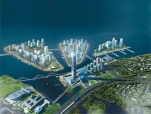Polycentric Model of Cities Development

After two decades of stagnation and slackening in the Russian urban planning, “super power” aspirations returned in our country known once by its unprecedented range of architectural experiments (from Peter the Great to Soviet constructions). The last year Moscow almost doubles its area; an international competition on developing a project “Development concepts for Moscow agglomeration” is now carrying out on initiative of Russian and capital governments. A chain of dramatic events proceded; they referred to the General capital development plan in force and protest wave perceived the last administration’s attempt to legitimate results of the quite faulty architectural policy which contradicts to principals of democratic society which we want to become in. Followed protest actions directed on saving the Himkinskiy wood and Moscow historical urban environment completed with a statement of new capital mayor who declared that the project “Moscow- City” fostered by aspirations of the previous government is an architectural error. In that way a great reload started in Moscow and Russian town planning based on the idea of decentralization; and after the initiation of a project of out-of-town business cluster “Skolkovo”, federal authorities decided to follow the lead of the innovative business and declared an intention to leave Kremlin and levee of the river Moskva in future and move in newly added territories outside the Moscow ring road.
A scale of great planning migration is measured by tens and even hundreds of milliards. They objectively say that the load had all bases, Moscow didn’t win a place higher than 169 by the level of life quality among 215 world cities in the international authoritative rating Mercer. Moscow takes one of the first places between European cities in shows of the population density for 1 km2 (taking into account unregistered citizens and tourists the index achieves 12 thousand people per 1 km2). A comfort in the city is measured by a quality of living space in territory, citizens combat for it everywhere: on roads paralyzed by jams, in overfilled buses and queues on escalators in metropolitan, plus a war for parking places and territories near houses... A deficit of free sites for construction in the maximally overstocked megalopolis made the Russian capital one of the most expensive world cities long ago. Thanks to adding of a part of Moscow region with an area of 144 thousand hectares, Moscow will become bigger in 2.4 times; naturally, the population density should reduce; strategically, it is a global decision of the issue, but the process will last many years and decades.
However, it is symbolic in the Moscow history that the theory of polycentric urban model for the city development growing before in accordance with the classical radialcircular scheme won. Moscow like a majority of European cities appeared from a fortress expanding during centuries, absorbing housing estate by new fortified wall rings, which went out borders of the old modification.The main problem of similar cities is that they isolate themselves. Quite effective and compact ring scheme existing inside the fortress doesn’t destine for further development with considerable increase of building density, in addition, the infrastructure was found absolutely helpless for motor transport application. Crowded cities grow upwards, erecting skyscrapers, and downwards, building metropolitans and underground road interchanges and parking.
These cities due to a huge concentration of population and infrastructure have a lot of social and ecological problems. The ideal polycentric model for developing similar megalopolis provides to delete borders between the city and satellites, develop transport infrastructure (accenting on public transport) between new centres and old city, a structure of which subjects to a cleaning due to a movement of industrial enterprises and planting vacated territories.
Sankt-Petersburg (the last year was crucial for the city too) is a diametrically opposite urban model and it is very interesting phenomenon for town planners’ investigations. As opposed to Moscow, the city rejecting the ring scheme by a Leblon’s general plan didn’t compactly develop inside fortified walls, but extensively around Petropavlovsk fortress built by Peter in Zayatchiy island. The radial-circular scheme of the ideal baroque town was realized in part by a sector around the triradial system with the spire of the Admiralty in the centre, and the architectural structure focused on a space of Neva as “the main town square”. In spite of a wide range of building works in the capital of Russian Empire, palaces and parks as a country residence of the imperial government were simultaneously erected in suburbs: Petergof, Oranienbaum, Strelna, Tsarskoye Selo, Pavlovsk.
It is demonstrative that the first railway in Russia was built for the communication between Sankt Petersburg, Tsarskoye Selo and Pavlovsk. A model of polycentric city founded in XVIII century was officially assigned by the General development plan of Leningrad in 1935, which provides a total retention of historical centre and movement of new building accent in south territories free from the flood when water in Neva walk up: centre of new city was planned on a crossing of Moscovskiy and Leninskiy Avenues. But the last ambitious and very beautiful general plan in the history of the city wasn’t realized, posterior plans only fixed a lack of architectural aspirations, financial funds and political will in the city.
Full version you can download here
 The text by Philip Nikandrov, main architect of the close corporation “GORPROEKT ”, main architect of the project “Lahta Centre”
The text by Philip Nikandrov, main architect of the close corporation “GORPROEKT ”, main architect of the project “Lahta Centre”


